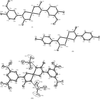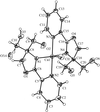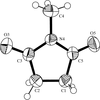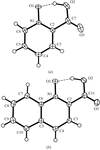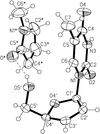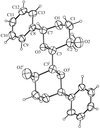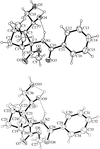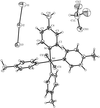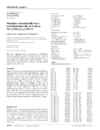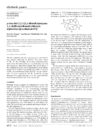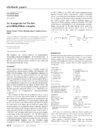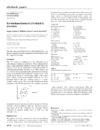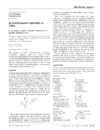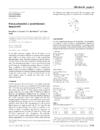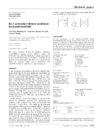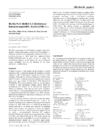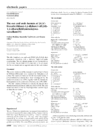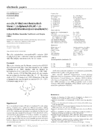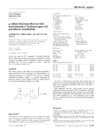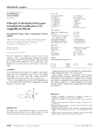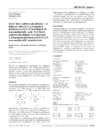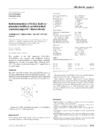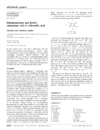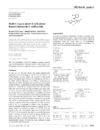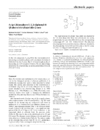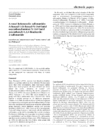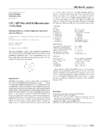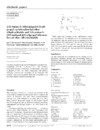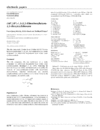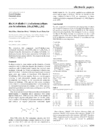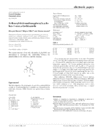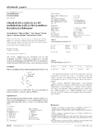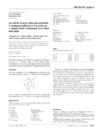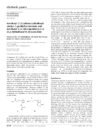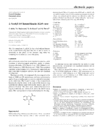issue contents
May 2000 issue

Cover illustration: A simplified packing diagram showing the anionic network of tris(2,2'-bipyridyl)nickel(II) thiosulfate heptahydrate, with H atoms omitted. See Freire et al. [Acta Cryst. C56, 541-543].
inorganic compounds
Download citation


Download citation


The framework of Na2Co(H2PO4)4·4H2O is built up from cobalt complex ions of the form [Co(H2PO4)4(OH2)2]2− connected via hydrogen bonds.
Download citation


Download citation


KNi3(AsO4)(As2O7) has a three-dimensional open anionic framework comprised of NiO6 octahedra, AsO4 tetrahedra and As2O7 groups sharing corners and edges. These delimit parallel tunnels running aong the b direction in which the K+ ions are located.
Download citation


Download citation


A three-dimensional hydrogen-bonded network exists between [Co(SeO3)(NH3)4]NO3 and the water molecule. The nitrate anion and water molecule form open pores in the structure when hydrogen bonded to two neighboring [Co(SeO3)(NH3)4]+ cations.
Download citation


Download citation


A re-investigation of the caesium titanyl arsenate room-temperature structure using a single-domain crystal shows that there is a substantial disorder of the Cs atoms over additional sites.
Download citation


Download citation


The crystal structure of the title compound is built up from face-sharing TiF6 antiprisms and KF12 polyhedra. The compound seems to be optically isotropic at approximately 720 nm.
metal-organic compounds
Download citation


Download citation


Download citation


Download citation


Download citation


Download citation


Download citation


Download citation


Download citation


Download citation


Download citation


Download citation


Download citation


Download citation


Download citation


Download citation


Download citation


Download citation


Download citation


Download citation


Download citation


Download citation


Download citation


Download citation


Download citation


Download citation


Download citation


Download citation


Download citation


Download citation


Download citation


Download citation


Download citation


Download citation


Download citation


Download citation


organic compounds
Download citation


Download citation


Download citation


Download citation


Download citation


Download citation


Download citation


Download citation


Download citation


Download citation


Download citation


Download citation


Download citation


Download citation


Download citation


Download citation


Download citation


Download citation


Download citation


Download citation


Download citation


Download citation


Download citation


Download citation


Download citation


Download citation


Download citation


Download citation


Download citation


Download citation


Download citation


Download citation


Download citation


Download citation


Download citation


Download citation


Download citation


Download citation


Download citation


Download citation


Download citation


Download citation


Download citation


Download citation


electronic papers (inorganic compounds)
Download citation


Download citation


In the title compound, the anion has the I atom on an inversion centre and exhibits non-crystallographic symmetry close to  m. The cations are bonded exclusively to water ligands, in contrast to the situation in the disodium cobalt(II) salt [Rosu & Dickman (1999). Acta Cryst. C55, 11–13].
m. The cations are bonded exclusively to water ligands, in contrast to the situation in the disodium cobalt(II) salt [Rosu & Dickman (1999). Acta Cryst. C55, 11–13].
electronic papers (metal-organic compounds)
Download citation


Download citation


The title compound contains a linear [Re2O3]4+ core and hexacoordinate ReV atoms. There is an inversion centre at the central bridging O atom. There is an inversion centre at the central bridging O atom. The distorted octahedral coordination of the ReV atom consists of an N2O2 donor set from the tetradentate imine–phenol ligand.
Download citation


Download citation


The crystal structure of pentacarbonyl(pyrrolidin-2-ylidene)chromium(0) shows strong interaction between the lone pair at nitrogen and the carbene C atom, and a weak intermolecular hydrogen bond between N—H and a carbonyl ligand.
Download citation


Download citation


In the title compound, [SnCl3(CH3)(C6H5SOCH2)2]n, determined as part of structural studies on adducts of halide–organotin compounds with sulfoxide derivatives, the octahedral SnIV centres are bridged by meso-1,2-bis(phenylsulfinyl)ethane ligands forming infinite chains along the [100] direction.
Download citation


Download citation


The title compound is isostructural with the copper(II) analogue. The structure consists of complex cations linked by hydrogen bonds to acetate anions.
Download citation


Download citation


The structure of the title compound at 298 K is virtually identical to the 173 K structure reported previously [Weng, Das & Robinson (1990). Malays. J. Sci. 12, 57]. The primary coordination of the Sn atom in both molecules of the asymmetric unit is in the form of a distorted tetrahedron. The distortion towards a trigonal-bipyramidal arrangement is brought about by a weak interaction between the Sn atom and the carbonyl O atom of the benzoate moiety.
Download citation


Download citation


In the structure of the title compound, the W atom is octahedral with one axial and four equatorial carbonyl groups, and with an axial monodentate dipyridylamine ligand having the secondary amine NH and the uncoordinated pyridyl N atom directed towards and away from the W atom, respectively.
Download citation


Download citation


The crystal structure of the title complex, studied as part of a systematic investigation of Mo(W) main-group hybrid clusters, contains discrete [BiI6]3− anions together with (HNC5H5)+ and (CH3COCH2NC5H5)+ cations separated by normal van der Waals contacts. The [BiI6]3− anion has the Bi atom on an inversion centre. The (HNC5H5)+ cation also lies about an inversion centre and is disordered. The (CH3COCH2NC5H5)+ cation lies in a general position.
Download citation


Download citation


The title centrosymmetric copper(II) binuclear complex, prepared to observe how C—Se bonds are activated by transition metal active centers, is built from two symmetry-related [Cu{Se2CN(Et)2}2] units by pairs of Cu—Se bonds. The coordination geometry at the unique Cu atom is distorted square pyramidal, displaying Cu—Se distances ranging from 2.4091 (11) to 2.9095 (10) Å.
Download citation


Download citation


The title compound has a distorted square-pyramidal coordination with an Mn N bond length of 1.516 (2) Å at the apical position. The central five-membered chelate ring adopts a gauche conformation with the two phenyl groups in equatorial orientations.
Download citation


Download citation


The title complexes show monomeric structures with a distorted square-pyramidal coordination. The two phenyl groups on the central five-membered chelate ring are both on the same side of the oxo ligand for the exo> isomer and on the opposite side for the endo> isomer.
Download citation


Download citation


The title mononuclear oxovanadium(IV) complex has a distorted square-pyramidal coordination. The complex was shown to be the exo> isomer.
Download citation


Download citation


The title mononuclear iron(II) complex has a slightly distorted octahedral coordination. One of the thiocyanate ions and one of the water molecules of crystallization show positional disorder.
Download citation


Download citation


The title complex shows a binuclear cage structure having an inversion centre. There are intramolecular N—H⋯O hydrogen bonds between the 7-azaindole ligands and the bridging acetate O atoms.
Download citation


Download citation


In the title complex, two [Mn(salen)] moieties are connected through a μ-acetate bridge in a syn–anti fashion. The Mn⋯Mn distance is 5.365 (1) Å.
Download citation


Download citation


In the title dinuclear CuII compound, the coordination geometry around the Cu atoms is square pyramidal, with the bridging Cl atom at the apical positions. The Cu—Cl—Cu angle is 136.9 (1)° and the Cu⋯Cu distance is 4.961 (1) Å.
Download citation


Download citation


The title mononuclear copper(II) complex shows a distorted square-planar coordination. The benzoylamino N atom does not coordinate to the Cu atom and is involved in a weak bifurcated hydrogen bond with two F atoms of the hexafluorophosphate anion.
Download citation


Download citation


The title mononuclear copper(II) compound shows a slightly tetrahedrally distorted square-pyramidal coordination with the chlorine ligand at the apical position. The directions of the two N—Me bond axes are syn with respect to the Cu—Cl bond.
Download citation


Download citation


The title mononuclear copper(II) complex shows a square-pyramidal coordination with the diethylamino N atom at the apical position. Large anisotropies in the displacement parameters of the non-H atoms of the ligand seem to be due to rotational disorder of the ClO4− anion.
Download citation


Download citation


The two title mononuclear oxovanadium(IV>) complexes, (I>) and (II>), respectively, have distorted square-pyramidal coordination and the 3-carboxy groups form intramolecular O—H⋯O hydrogen bonds with the coordinated salicyl O atoms. In complex (I>), the methanol ligand coordinates to the V atom trans with respect to the oxo ligand and is involved in an intermolecular O—H⋯O hydrogen bond.
Download citation


Download citation


The structure of the title copper(II) complex has been redetermined from an untwinned crystal. The structure was originally reported with insufficient accuracy because of a twinning problem [Adams, Bailey, Campbell, Fenton & He (1996). J. Chem. Soc. Dalton Trans. pp. 2233–2237]. The dinuclear phenolate-bridged CuII complex, which displays a long Cu–phenolic O atom bond, has an inversion centre.
electronic papers (organic compounds)
Download citation


Download citation


In the crystals of the two title salts of chloranilic acid, the chloranilate ions are present as hydrogen-bonded dimers lying about inversion centres. The ethylammonium and diethylammonium ions link the dimers through N—H⋯O hydrogen bonds, forming a three-dimensional hydrogen-bond network in one structure and a one-dimensional chain in the other.
Download citation


Download citation


The title compound contains a planar isoxazole ring. An intramolecular hydrogen bond is formed between the OH group attached to a phenyl ring and a carbonyl O atom.
Download citation


Download citation


In the title compound, the β-lactam ring is essentially planar. The C—C bond opposite the lactam C—N bond is significantly lengthened to 1.591 (2) Å because of the ring substituents.
Download citation


Download citation


The study of acetazolamide-derived sulfonamides has led to the preparation and crystallographic characterization of a new member of this family of compounds with potential carbonic anhydrase inhibitory properties.
Download citation


Download citation


The title compound, N1-[4-(1,1-dimethylpropyl)benzylidene]pyridine-2-carboxamidrazone, is a particularly active antimycobacterial agent. Its aromatic rings are linked by a fully extended chain, with only small twists. The amino group makes intra- and intermolecular N—H⋯N contacts.
Download citation


Download citation


In the title compound, the Z configuration has been confirmed. The molecular structure shows an intramolecular N—H⋯N hydrogen bond which could be responsible for the Z configuration.
Download citation


Download citation


The structure analysis of the title macrobicyclic 1,3-diketone establishes a trans configuration of the two fused rings.
Download citation


Download citation


The title molecules, (I>) and (II>), respectively, exhibit different histamine H3-receptor activity and they are used as model compounds for evaluation of the activation mechanism of the H3 receptor.
Download citation


Download citation


The title compound was synthesized as a model compound for substituted diequatorial fixed vicinal trans-cyclohexanediols.
Download citation


Download citation


The polyseleno title compound, bis(N,N-diethylselenocarbamoyl) triselenide, was obtained from the disproportion of sodium N,N-diethyl-1,1-diselenocarbamate. An Se atom connects two N,N-diethyl-1,1-diselenocarbamate groups with Se—Se distances in the range 2.4500 (11)–2.8601 (12) Å.
Download citation


Download citation


The title thioamide undergoes photocyclization in the solid state. The central C=C—N—C(=S)—C=C moiety adopts a shape like a portion of a helix. Intramolecular rotation of the N—Ph ring does not seem to be disturbed by the 4-methoxy group.
Download citation


Download citation


The relative configuration was determined for the title compound, which was prepared in a synthetic study on immunosuppressant FR65814. There is an intramolecular hydrogen bond between the hydroxy and epoxy groups.
Download citation


Download citation


The relative configuration was determined for the title compound, which was prepared in a synthetic study on the natural product sphingofungin E. The six-membered ring adopts a chair form and the five substituents are all in axial positions.
Download citation


Download citation


The title compounds, (I>) and (II>), respectively, are two minor products of the reaction of tert-butyl 2-(2-amino-3-pyridyloxy)acetate with thiophosgene in chloroform. Compound (II>) contains the novel 1,2,4-thiadiazolo[4,3-a]pyridine-3-thione fused-ring system.
Download citation


Download citation


The title compound has a boat-shaped heterocyclic six-membered ring such that the S and N atoms lie essentially in the plane of the benzene ring while the remaining two C atoms are above this plane.


 journal menu
journal menu


















